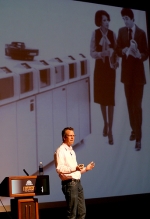2008 HighEdWeb Conference

HighEdWeb is a conference for web professionals in higher education. This year’s conference was held at Missouri State University in Springfield, Missouri at the Plaster Student Union. The High Ed Web conference was the first web development conference I’ve been to. As an undergraduate at the University of Nebraska, I was heavily involved in SIFE (Students In Free Enterprise) business competitions, and in later years, I attended the Worship Institute. What made this conference exceptional was everyone had a laptop.
 As you went from session to session, everyone had their laptop open. Twitter was also used every second of the day for social networking. The most exciting part is that #HeWeb08 was ranked in the top 10 most active mentions.
As you went from session to session, everyone had their laptop open. Twitter was also used every second of the day for social networking. The most exciting part is that #HeWeb08 was ranked in the top 10 most active mentions.
 One of the most inspiring sessions at the conference was the keynote message by Jeffery Veen. As we constantly work with data sets, the most crucial aspect of that data set is visualizing it. Visualizing data is nothing foreign to Jeffery Veen. Jeff worked for Google in the redesign process for their analytic products. As he spent years working on visualizations, he learned how visuals have been used in history to solve problems. Jeff shared some people in history who had revolutionized how we look at numbers or make connections to places or ideas.
One of the most inspiring sessions at the conference was the keynote message by Jeffery Veen. As we constantly work with data sets, the most crucial aspect of that data set is visualizing it. Visualizing data is nothing foreign to Jeffery Veen. Jeff worked for Google in the redesign process for their analytic products. As he spent years working on visualizations, he learned how visuals have been used in history to solve problems. Jeff shared some people in history who had revolutionized how we look at numbers or make connections to places or ideas.
The first example Jeff shared was John Snow. John Snow was a physician who studied cholera cases in London in 1854, a time known as the Black Death. Though much speculation was that the disease was being spread by polluted air, John proposed that the source of the disease was coming from a water source based on cases that occurred on a map and the use of statistics to prove the connection to the disease.
Following Jeff shared another example of Charles Joseph Minard. Charles studied the changes in the population of Napoleon’s army during Napoleon’s invasion campaigns. He stated,
“The aim of my carte figurative is to convey promptly to the eye the relation not given quickly by numbers requiring mental calculation.”
Essentially, as Jeff summarized it, “Don’t make me think.” A quotation from Chris Jordan creates a further clarity in the importance of the power of visualization,
“Statistics can feel abstract and anesthetizing, making it difficult to connect with and make meaning.”
Chris creates meaning with his visuals of small items to portray the bigger picture.
Though there was so much that Jeff spoke about, Jeff shared the following highlights from his experience:
- Find a story in the data
- Assign different visual cues to each dimension of the data
- Remove everything that isn’t telling the story
- Enable people to find their stories
- Create tools to let them manipulate their data
- Provide filters to enable clarity
Some recommended reading by Jeff:
- “Visualizing Data: Exploring and Explaining Data with the Processing Environment”, Ben Fry.
- “The Visual Display of Quantitative Information”, Edward R. Tufte.
- “Envisioning Information”, Edward R. Tufte.
- “Visual Explanations”, Edward R. Tufte.
- “Beautiful Evidence”, Edward R. Tufte.
- “Mental Models: Aligning Design Strategy with Human Behavior”, Indi Young.
- “The Ghost Map”, Steven Johnson.
Check out the conference site! High Ed Web 2008 Conference